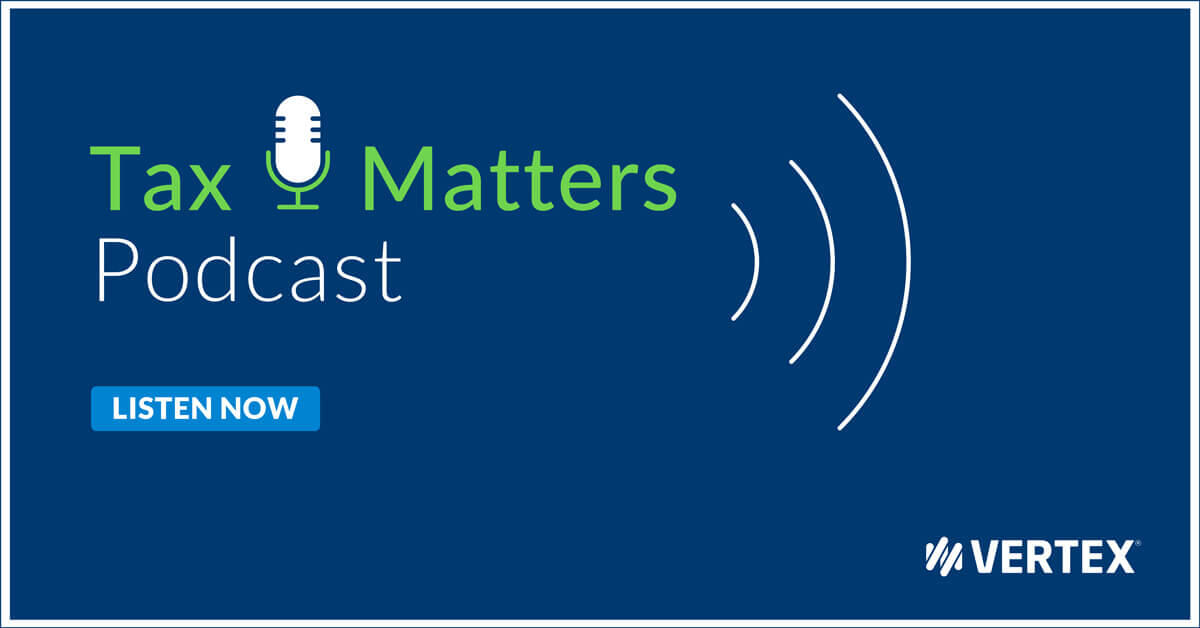Tricia Schafer-Petrecz: Welcome to Tax Matters, a Vertex podcast! I’m Tricia Schafer-Petrecz, External Communications Lead at Vertex. In this episode, Vertex Principal Architect of Innovation Eric Christian gives business writer Eric Krell the lowdown on edge computing.
Eric shares his thoughts on how edge computing can help tax groups improve connectivity, availability, security, and customer experience. Vertex O Series Edge, our new cloud-based system, gives retailers and other companies access to these benefits and more. Eric also discusses how edge computing provides value and how he expects it to evolve over time.
Now, I’ll turn it over to Eric and Eric…
Eric Krell: Let me start by asking you what edge computing is…
Eric Christian: Thanks, Eric. Edge computing is really just an architecture. It's an architecture where you're taking the critical processing and putting it at the point of need. So, wherever that customer needs transaction processing, that's where you put it -- as opposed to traditional cloud computing, where that computation is performed in the Cloud or remotely far away.
Eric Krell: In the past year or so, I’ve most often heard edge computing used in relation to Internet of Things (IoT) applications. How does edge computing applies to the tax department and to tax calculations?
Eric Christian: That's a good question. The reason you're hearing about Internet of Things and edge computing is because it makes sense. …Think of a fitness app. If you have a fitness app on your wrist, it's calculating or monitoring your heart rate the entire time. Well, it's not sending a signal up to a centralized system somewhere, certainly not in real time. What it's doing is monitoring your heart rate, so you can look down at your wrist and see what your heart rate is. Periodically, the app will send data to a centralized server so that you can look at reports and statistics over time. That’s how it's engineered. That's how it's architected.
Well, we want to do the same kind of thing with tax. Think about the most important part of tax determination, it's the calculation point. It's calculating the tax for that transaction, which you want to have happen as quickly and reliably as possible. We want that piece to occur at that point of need, but we also want to have all of that transactional data and information at a central point for reporting purposes. So, it’s the same type of concept as a fitness app.
Eric Krell: Vertex now has an edge computing offering. Fill me in on what that is, and tell me what types of industries or companies it’s best suited for right now.
Eric Christian: We’re really excited about this. It's called O Series Edge. It’s a product that works with O Series. Now, O Series is the traditional tax engine offered by Vertex. Users log into the application and configure a variety of different things: their nexus profile, product mappings, exemption certificates, and things like that. Traditionally, that same system calculates the tax for them. Now, that system is large, requires a big footprint and a lot of infrastructure. It can either be hosted by Vertex in the Cloud or some larger organizations install it on-premise and devote large servers to the software. What we're doing with O Series Edge is containerizing that calculation component and allowing that user to take that calculation component and place it wherever they want to.
Eric Krell: You mentioned “containerization” – what is a container?
Eric Christian: I think containerization is one of the most exciting things that’s happened in the whole IT world in the past 10 years. I believe it started around 2013. Companies figured out a way to fundamentally change the way we install software. If you think about how we install software traditionally, it kind of makes you scratch your head and go, "Why did we do it this way?" You have an operating system, and then you may have a Java virtual machine (JVM) , an app server, and a database – all of these pieces and parts. And all of these pieces and parts have different versions that all have to work together…. If one of those pieces change, then things break. That's a real challenge for IT organizations, and it has been for decades.
Containerization does something remarkable: It bundles everything we need together into one small footprint and can be deployed anywhere. You can take a container and place it on a Windows machine or a Linux machine. It doesn’t really matter because it’s all going to run the same because it contains everything it needs, including the operating system. Again, it’s remarkable way of managing software, and I'm excited to see that tax technology is heading in this direction.
Eric Krell: Getting back to O Series Edge, why would, say, a retail company with physical stores deploy this solution? In other words, what common pain points is the solution designed to address?
Eric Christian: Retail is a great example of an industry that really needs more advanced transaction tax automation. If you think of a retail brick-and-mortar, it was always a pretty simple task to calculate tax. You knew where the transaction was taking place. Once you figured that out, you had a limited number of decisions to make.
Well, that whole world's changed now … Think about buying online, returning to store; buying online, shipping to store; going to store, shipping to home -- all of these kinds of things are happening at most retailers now. And their tax systems have to accommodate for that. What we see in the retail space is that point-of-sale (POS) software typically has a small calculator, and companies have to feed that calculator with data. Sometimes it's an automated solution, sometimes it's literally a manager in a store typing in the rates for their store, and a variety of solutions in between. Well, that's not a real tax calculation engine. It's not managing all those nuances that those stores deal with every day, like ship to homes and those all-too-common challenging scenarios like clothing over $112 is taxable while clothing under $110 is exempt, or tax holiday scenarios.
All of those complexities make it necessary for a retailer to have a true tax engine. The only problem with having a true tax engine traditionally is that you have to make a call out to a remote server. Well, that's not practical. And you can't have a big, massive server in each and every store. What you need is a very small lightweight tax engine, and that's where O Series Edge comes in. We're providing that small tax calculator that they can put it anywhere they want.
Eric Krell: What benefits would the company gain from the solution?
Eric Christian: For traditional retailers, it's giving them a true tax engine. That's number one. For other industries, such as large e-commerce providers, it brings to them some basics that they definitely need. Keep in mind that the transactions they're processing are their revenue, so it's critical that they are able to calculate tax quickly and accurately. If they have to go across the Internet to get the tax and come back, there is some risk there. There's a risk of a failed transaction and of slow performance. By introducing O Series Edge and edge computing into transaction tax automation, we're increasing performance because we don't have that network latency. We’re improving reliability by eliminating those possible points of failure. We’re improving security because that transaction is not leaving that company's firewall. You’re also improving the security of your own data. The personally identifiable information that might be in that transaction is not leaving your firewall. Of course, you could also deploy these containers in countries that mandate that their data remain within their borders.
Eric Krell: Which is huge given all of the data privacy regulations coming online around the world right now. Eric you mentioned reliability and security, but are there also some resilience benefits?
Eric Christian: Oh, absolutely. One of the beauties of using containers is that you have the ability to scale utilizing some standard tools out there, which are absolutely fantastic, so you can deploy a container and say, "I want that deployed on three separate servers running all the time, but if my demand gets higher, I want to increase it up to 10 servers and then drop back down when the demand decreases.” If one of those servers goes down, you have load-balancers that will direct the traffic to the live systems and away from the systems that are not live. So, yes, by taking advantage of containerization, we're really adding the ability to have that resilience, which is so critical.
Eric Krell: What if any Vertex applications does a company need to have in place in order to deploy the Edge product?
Eric Christian: All they're going to need is O Series. That could be O Series On-Demand or O Series on- premise.
Eric Krell: Before we sign off, what can you tell me about possible future applications of edge computing in the tax realm?
Eric Christian: My whole world is transaction tax automation, and it's been that way my entire career. So I'm really excited about seeing edge computing in all other aspects of our industry, that includes exemption certificate management, reporting, returns, and all of those other components that we deal with all the time.
Eric Krell: Well, Eric, thanks for taking the time today. It sounds exciting, and I look forward to reconnecting with you on edge computing soon.
Eric Christian: Sounds great, thank you.
Tricia Schafer-Petrecz: Thank you for listening to Tax Matters, a Vertex podcast…Check back here for more episodes soon.


